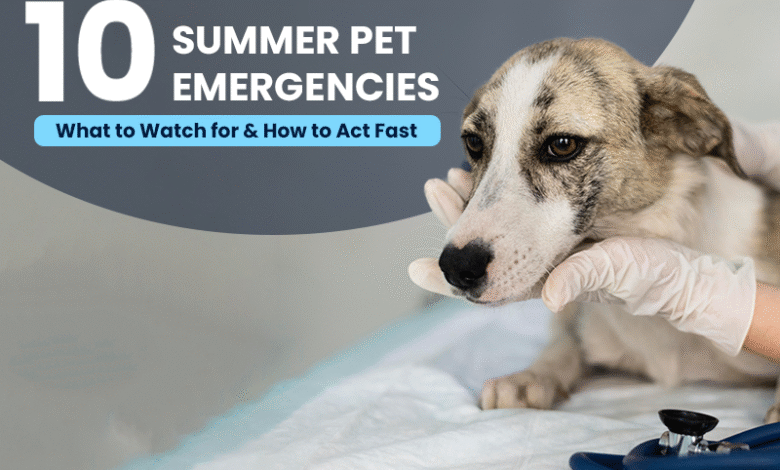10 Summer Pet Emergencies: What to Watch for & How to Act Fast

As a pet parent, you must be aware of how important it is to keep your pet safe all year round. While all weathers come with their own sets of challenges, summer is particularly harsh on pets and calls for frequent visits to the veterinarian. But don’t worry, as we’re here to help.
In this blog, we’ll shed light on some of the common summer pet emergencies and ways to combat them. Read on to find out more.
Common Pet Emergencies in Summer
Let’s take a look at some of the common emergencies that pets encounter during summer.
1. Heatstroke
Heatstroke is one of the common summer emergencies that call for veterinary visits. As dogs and cats don’t sweat like humans, their bodies overheat quickly during hot weather. Even if you keep them a few minutes in a parked car without an air conditioner or expose them to the sun for a long time, they can face life-threatening heatstroke. Signs of heatstroke include vomiting, weakness, drooling, panting and collapse. If you suspect that your pet is experiencing heatstroke, do not delay and seek immediate medical help.
2. Flea and Tick infestations
Summer comes with an increased risk of parasite infestation in pets. Organisms like fleas and ticks tend to attack our furballs and cause multiple health problems like:
· Allergic reaction
· Skin irritation
· Excessive scratching,
· Hair loss,
· Diarrhea,
· Vomiting
· Lethargy
Treatments like NexGard for Dogs, Bravecto, Simparica Trio for Dogs, Frontline Plus, Bravecto Plus and Revolution Plus work well to keep dogs and cats protected from fleas and ticks.
3. Dehydration
Dehydration in pets during summer is a serious concern. It occurs when they lose more fluid than they intake. Puppies, senior canines, nursing queens and toy breeds tend to have an increased risk of dehydration. Symptoms of dehydration may include loss of appetite, loss of skin elasticity, lethargy, vomiting, panting and dry nose.
4. Burned Paw Pads
During summer, the roads, sidewalks and sands tend to heat up severely. If you notice your pet is limping, refusing to walk or has reddened paws, it may be because of thermal burns. The injuries can lead to infection and call for immediate medical help.
5. Wildlife Encounters
Wild animals, especially snakes, are more active in summer than in other seasons. Pets being curious in nature can stumble across snakes and other wild animals like porcupines and raccoons, and become an easy target. Bites and stings from such animals can lead to infections and allergic reactions.
6. Sunburn
Many pet parents believe that their furry babies are protected from the sun’s harmful rays due to their hairiness. However, in reality, they need protection just as we do. Dogs and cats, especially the ones with light-colored hair, pale skin, and thin coats, lack natural protection and can easily suffer sunburn. Also, if your pet spends more time outdoors, it may fall prey to the harsh rays of the sun.
Petkin’s Doggy Sunmist, Doggy Sunsticks and Sunwipes work well to protect dogs from the harmful ultraviolet rays of the sun. Also, Dermoscent Sunfree protects both dogs and cats from harsh sun rays.
7. Drowning or Water-Related Accidents
As not all pets are natural swimmers, drowning or near-drowning incidents are not unheard of. Therefore, it is important that you keep a close watch on your pet when it is swimming in pools or lakes. If it shows signs like lethargy, coughing or respiratory distress post-swimming, it may be because it has ingested water. In such cases, you should get it checked by the vet.
8. Environmental Allergies
With the rise in temperature, there is always a spike in pet allergies. The increased exposure to fleas, pollens and other environmental irritants causes many canines to experience allergies. Symptoms of pet environmental allergies include redness, hot spots, rashes, hair loss, coughing, sneezing, wheezing, vomiting and diarrhea.
9. Toxic Food Ingestion During Barbecues & Picnics
We know that backyard cookouts during summer are a lot of fun. But if you have a pet, you should be cautious as it may end up eating scraps like corn cobs, ribs, greasy food and skewers that can make them sick. If you suspect your pet has ingested something harmful, don’t wait and get in touch with the vet immediately.
10. Exposure to Lawn Chemicals & Poisonous Plants
As pets tend to spend time outdoors during summer, they end up getting exposed to the pesticides present in lawn chemicals and ingesting poisonous plants. It can lead to symptoms like vomiting, diarrhea, seizures and even organ failure. Therefore, if you suspect that your pet has consumed any type of poison, take it for a medical check-up.
Common Summer Diseases
Summer, with its temperature rise and increased outdoor activities, exposes pets to a wide range of diseases, including Lyme Disease, Heartworm Disease, Leptospirosis, Ehrlichiosis and Anaplasmosis.
You may seek your vet’s advice to understand how to prevent them so as to keep your dog safe and protected.
Wrapping Up
Now that you’ve learned a lot regarding pet summer health issues, you must be all set to have a lot of fun with your furry baby. Just remember that, irrespective of the species of your pet, you must be vigilant and look out pet health issues like heatstroke and animal bites. You should also be prepared for emergency vet visits if you notice any serious symptoms.




